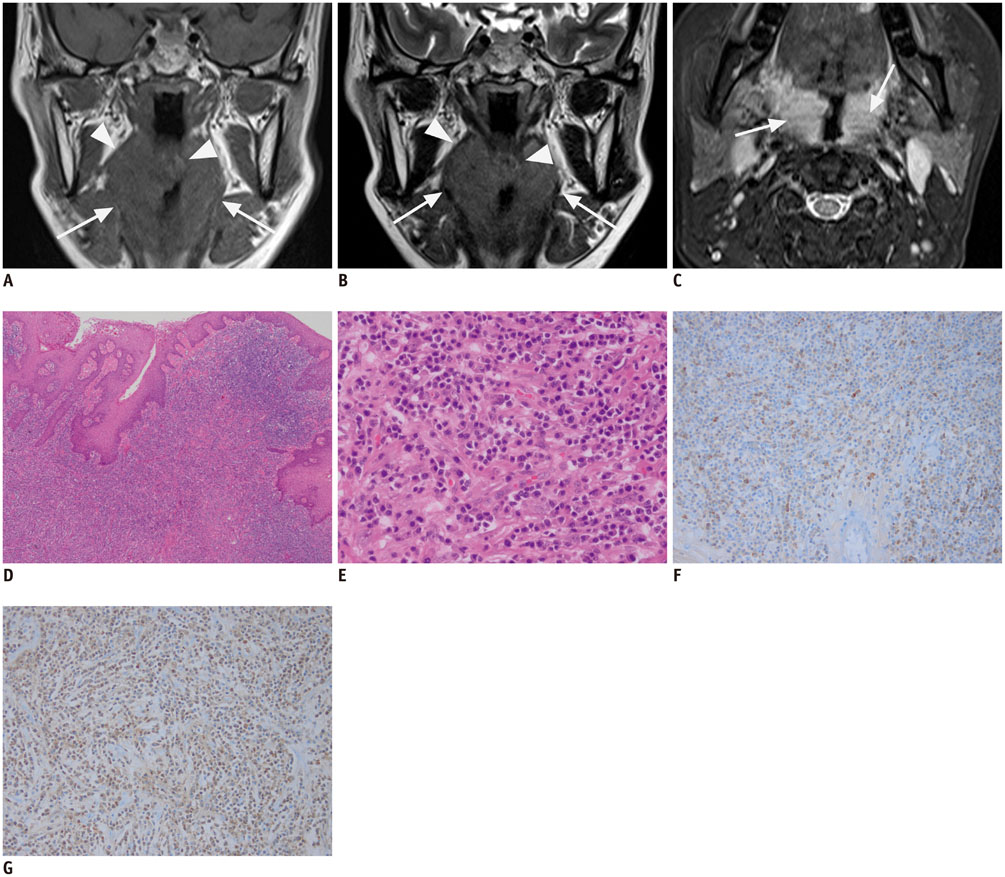Korean J Radiol.
2016 Feb;17(1):147-150. 10.3348/kjr.2016.17.1.147.
Immunoglobulin G4-Related Sclerosing Disease Manifesting as Bilateral Tonsillar Hypertrophy on MR Images: A Case Report
- Affiliations
-
- 1Department of Radiology, Hallym University College of Medicine, Kangnam Sacred Heart Hospital, Seoul 07441, Korea. baccas@hallym.or.kr
- 2Department of Radiology, Hallym University College of Medicine, Kangdong Sacred Heart Hospital, Seoul 05355, Korea.
- 3Department of Pathology, Hallym University College of Medicine, Kangnam Sacred Heart Hospital, Seoul 07441, Korea.
- KMID: 2351174
- DOI: http://doi.org/10.3348/kjr.2016.17.1.147
Abstract
- Immunoglobulin G4-related sclerosing disease (IgG4-SD) is currently recognized as a distinct systemic disease involving various organs. We reported the imaging findings of a case of pathologically confirmed IgG4-SD involving bilateral palatine tonsils. CT and MRI showed diffuse enlargement of both palatine tonsils with homogeneous contrast enhancement. Focal contour bulging was noted in the right palatine tonsil. Lesions appeared as isointense on T1-weighted and slightly hyperintense on T2-weighted MRI images, as compared with muscle. The T2-weighted MRI image showed a striated pattern in both tonsils. Despite its rare occurrence, IgG4-SD should be included in the differential diagnoses of patients with symptomatic bilateral tonsillar hypertrophy that is non-responsive to medication.
MeSH Terms
Figure
Cited by 1 articles
-
Immunoglobulin G4-Related Disease Affecting the Tonsil: Case Report and Literature Review
Hye-kyung Shim, Mi Ra Kim
Korean J Otorhinolaryngol-Head Neck Surg. 2024;67(5):300-304. doi: 10.3342/kjorl-hns.2024.00129.
Reference
-
1. Kamisawa T, Funata N, Hayashi Y, Eishi Y, Koike M, Tsuruta K, et al. A new clinicopathological entity of IgG4-related autoimmune disease. J Gastroenterol. 2003; 38:982–984.2. Katsura M, Mori H, Kunimatsu A, Sasaki H, Abe O, Machida T, et al. Radiological features of IgG4-related disease in the head, neck, and brain. Neuroradiology. 2012; 54:873–882.3. Khurram SA, Fernando M, Smith AT, Hunter KD. IgG4-related sclerosing disease clinically mimicking oral squamous cell carcinoma. Oral Surg Oral Med Oral Pathol Oral Radiol. 2013; 115:e48–e51.4. Hamano H, Kawa S, Horiuchi A, Unno H, Furuya N, Akamatsu T, et al. High serum IgG4 concentrations in patients with sclerosing pancreatitis. N Engl J Med. 2001; 344:732–738.5. Kamisawa T, Okamoto A. IgG4-related sclerosing disease. World J Gastroenterol. 2008; 14:3948–3955.6. Okazaki K, Uchida K, Koyabu M, Miyoshi H, Takaoka M. Recent advances in the concept and diagnosis of autoimmune pancreatitis and IgG4-related disease. J Gastroenterol. 2011; 46:277–288.7. Vlachou PA, Khalili K, Jang HJ, Fischer S, Hirschfield GM, Kim TK. IgG4-related sclerosing disease: autoimmune pancreatitis and extrapancreatic manifestations. Radiographics. 2011; 31:1379–1402.8. Ko Y, Woo JY, Kim JW, Hong HS, Yang I, Lee Y, et al. An immunoglobulin G4-related sclerosing disease of the small bowel: CT and small bowel series findings. Korean J Radiol. 2013; 14:776–780.9. Coulier B, Montfort L, Beniuga G, Pierard F, Gielen I. Small bowel obstruction caused by peritoneal immunoglobulin g4-related disease mimicking carcinomatosis: case report. Korean J Radiol. 2014; 15:66–71.10. Choi JW, Kim SY, Moon KC, Cho JY, Kim SH. Immunoglobulin G4-related sclerosing disease involving the urethra: case report. Korean J Radiol. 2012; 13:803–807.11. Rossi M, Virgilio E, Laurino F, Orgera G, Menè P, Pirozzi N, et al. Giant hepatic artery aneurysm associated with immunoglobulin G4-related disease successfully treated using a liquid embolic agent. Korean J Radiol. 2015; 16:953–954.
- Full Text Links
- Actions
-
Cited
- CITED
-
- Close
- Share
- Similar articles
-
- Immunoglobulin G4-related sclerosing cholangitis
- A Case of Immunoglobulin G4-Related Sclerosing Disease Mimicking Lung Cancer
- Immunoglobulin G4-Related Sclerosing Disease Involving the Urethra: Case Report
- A Case of Immunoglobulin G4-Related Sialadenitis and Dacryoadenitis
- A Case of Recurrent Ischemic Stroke Associated with Immunoglobulin G4-Related Disease


